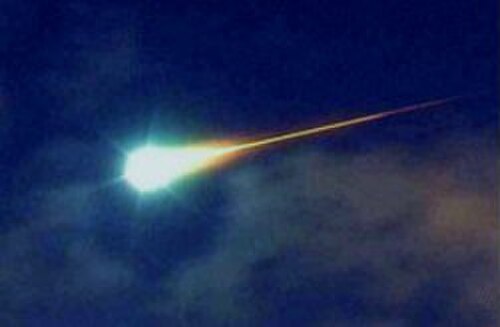Asteroids have played a huge role in shaping our planet’s history—some have even caused massive changes that we’re still talking about today. Let’s dive into what would happen if an asteroid were to hit Earth, using what we know from past events and current research.
How Often Do Asteroids Hit Earth?
Asteroids hit Earth more often than you might think, but most of them are so small that they burn up in the atmosphere and don’t cause any damage. The really big ones, the kind that could cause serious trouble, are much rarer. For example, an asteroid about 1 kilometer wide hits Earth roughly every 500,000 years. Bigger ones, around 5 kilometers in diameter, show up about once every 20 million years. When these giant space rocks hit, the impact depends on their size, speed, and the angle they hit at—45 degrees being the most likely.
 |
| Source: Wikimedia A stunning view of a bolide, a type of meteor that explodes in the atmosphere, illuminating the night sky with its bright trail. |
Big Asteroid Hits from History
The Tunguska Event (1908)
One of the most famous impacts in recent history happened in 1908 in Tunguska, Siberia. An asteroid or comet exploded in the sky, flattening about 80 million trees over 2,150 square kilometers. It’s a powerful example of what even a relatively small object can do.
 |
| Source: Wikimedia An artistic representation of the Tunguska event, which occurred in 1908 in Siberia, illustrating the extensive destruction of trees and the impact of the explosion on the landscape. |
The Chelyabinsk Meteor (2013)
In 2013, a 20-meter-wide asteroid entered Earth’s atmosphere over Chelyabinsk, Russia. It exploded with the force of 500,000 tons of TNT! The shockwave injured over a thousand people and caused a lot of property damage.
The Chicxulub Impact (66 Million Years Ago)
And then there’s the Chicxulub impact, the one that probably wiped out the dinosaurs. About 66 million years ago, a huge asteroid, between 10 and 15 kilometers wide, smashed into what’s now Mexico, leaving a crater 180 kilometers wide. It led to the extinction of about 70% of all species on Earth—talk about a game-changer!
What If an Asteroid Hit Today?
Physical and Environmental Effects
If an asteroid hit Earth today, what happens next depends on a lot of factors, like its size and where it lands. A big enough impact could cause massive destruction, injuries, and death, especially if it hit a populated area. Imagine a 1-kilometer-wide asteroid hitting a city—it would create a blastwave and fireball so powerful that millions could be at risk.
Climate Impact
Beyond the immediate devastation, an asteroid impact could throw up enough dust and smoke to block sunlight, plunging global temperatures and causing what’s known as an “impact winter.” This could lead to crop failures and a massive die-off of species, including possibly us.
Tsunamis and Flooding
If an asteroid hit the ocean, we’d be looking at enormous tsunamis. The waves could flood coastlines around the world, adding another layer to the disaster.
Can We Do Anything to Prevent It?
Detection and Deflection
Catching these asteroids before they become a problem is the first step. NASA and other space agencies have infrared telescopes scanning the skies for potential threats. If we spot one early enough, we might be able to change its course using techniques like the Double Asteroid Redirection Test (DART), which has shown that it’s possible to nudge an asteroid off its path.
Working Together
An asteroid impact isn’t just one country’s problem; it’s a global issue. That’s why international cooperation is key. Every two years, NASA leads simulations to prepare experts and decision-makers from around the world for what to do if we ever find ourselves in this situation.
Emergency Response
If we know an impact is coming, having emergency response plans in place is crucial. These plans involve everything from evacuations to coordinating international aid to minimize the damage and loss of life.
Wrapping It Up
Asteroids might not hit Earth often, but when they do, the consequences can be huge. Learning from past events like Tunguska and Chelyabinsk, and preparing through detection, deflection, and international cooperation, are our best bets for staying safe. So, while the idea of an asteroid impact might sound like something out of a sci-fi movie, it’s something we should take seriously—and luckily, we’ve got some smart folks working on it.
 |
| Source: Wikimedia An aerial photograph of the Barringer Crater, also known as Meteor Crater, which was formed by a meteorite impact approximately 50,000 years ago, illustrating its distinct geological features. |
By studying these cosmic events and advancing our technology, we can hope to avoid any nasty surprises from the sky.
Sources
- Impact Event Overview: Wikipedia - Impact Event
- Energy Release by Asteroids: Wikipedia - Impact Event: Energy Release
- Tunguska Event: The Planetary Society - Notable Asteroid Impacts
- Chelyabinsk Meteor: Earth.com - Chelyabinsk Meteor Impact
- NASA's Hypothetical Impact Scenario: NASA - Asteroid Impact Exercise
Related Content
- What Happens When an Asteroid Hits Earth? Space Camp Turkey
- NASA's Double Asteroid Redirection Test (DART): NASA - DART Mission Details
- Notable Asteroid Impacts in Earth's History: The Planetary Society



0 Comments